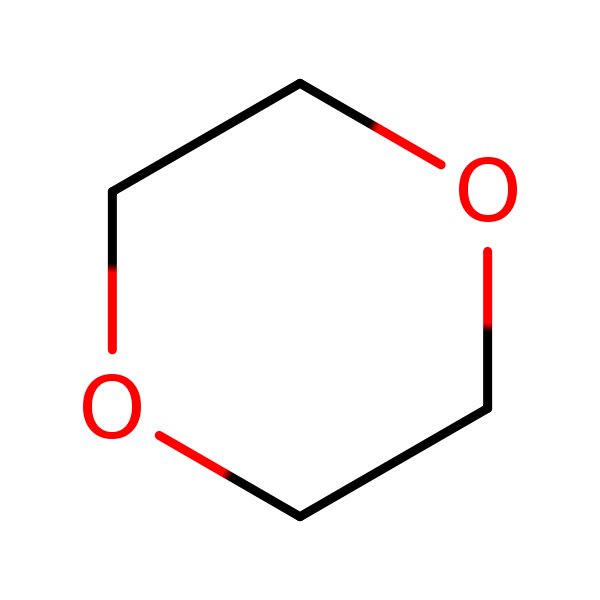1,4-Dioxane
CASRN 123-91-1 | DTXSID4020533
- Toxicological Review (PDF) (419 pp, 3.69 M)
- IRIS Summary (PDF) (32 pp, 291 K)
Noncancer Assessment
Reference Dose for Oral Exposure (RfD) (PDF)
(32 pp, 291 K)
Last Updated: 08/11/2010
| System | RfD (mg/kg-day) | Basis | PoD | Composite UF | Confidence |
|---|---|---|---|---|---|
| Hepatic, Urinary | 3 x 10 -2 | Liver and kidney toxicity |
NOAEL
:
9.6
mg/kg-day |
300 | Medium |
Reference Concentration for Inhalation Exposure (RfC) (PDF)
(32 pp, 291 K)
Last Updated: 09/20/2013
| System | RfC (mg/m3) | Basis | PoD | Composite UF | Confidence |
|---|---|---|---|---|---|
| Nervous, Respiratory | 3 x 10 -2 | Atrophy and respiratory metaplasia of the olfactory epithelium |
LOAEL
(HEC):
32.2
mg/m3 |
1000 | Medium |
Cancer Assessment
Weight of Evidence for Cancer (PDF)
(32 pp, 291 K)
Last Updated: 09/20/2013
| WOE Characterization | Framework for WOE Characterization |
|---|---|
| Likely to be carcinogenic to humans | Guidelines for Carcinogen Risk Assessment (U.S. EPA, 2005) |
- In accordance with the Guidelines for Carcinogen Risk Assessment (U.S. EPA, 2005), 1,4-dioxane is characterized as "likely to be carcinogenic to humans."
- This may be a synopsis of the full weight-of-evidence narrative.
Quantitative Estimate of Carcinogenic Risk from Oral Exposure (PDF) (32 pp, 291 K)
Oral Slope Factor:
1
x 10-1
per mg/kg-day
Drinking Water Unit Risk:
2.9
x 10-6
per µg/L
Extrapolation Method: Log-logistic model with linear extrapolation from the POD (BMDL50HED) associated with 50% extra cancer risk.
Tumor site(s): Hepatic
Tumor type(s): Hepatocellular adenoma and carcinoma (Kano et al. 2009)
Quantitative Estimate of Carcinogenic Risk from Inhalation Exposure (PDF) (32 pp, 291 K)
Inhalation Unit Risk:
5
x 10-6
per µg/m3
Extrapolation Method: Multi-tumor dose-response model with linear extrapolation from the POD (BMDL10HED) associated with 10% extra cancer risk.
Tumor site(s): Reproductive, Respiratory, Hepatic, Urinary, Gastrointestinal, Other
Tumor type(s): Multiple (nasal, liver, kidney, peritoneal, mammary gland, and Zymbal gland) (Kasai et al. 2009)
Sep 2013: IRIS Toxicological Review of 1,4-Dioxane (With Inhalation Update) (Final Report) (Report)
Sep 2011: IRIS Toxicological Review of 1,4-Dioxane (with Inhalation Update) (External Review Draft) (Report)
May 2011: IRIS Toxicological Review of 1,4-Dioxane (Interagency Science Consultation Draft) (Report)
Aug 2010: IRIS Toxicological Review of 1,4-Dioxane (Final Report, 2010) (Report)
Apr 2009: IRIS Toxicological Review of 1,4-Dioxane (External Review Draft, 2009) (Report)
Apr 2005: IRIS Toxicological Review of 1,4-Dioxane (Interagency Science Discussion Draft) 2010 (Report)
- Human Health Benchmarks for Pesticides (HHBP). This database provides human health benchmarks for pesticides that may be present in drinking water.
- Office of Pesticide Programs Pesticide Chemical Search. This database provides links to health effects information and registration status for pesticides.
- Chemistry Dashboard. This database provides information on chemical structures, experimental and predicted physicochemical, and toxicity data.
You will need Adobe Reader to view some of the files on this page. See EPA's PDF page to learn more.
Contact Us to ask a question, provide feedback or report a problem.










